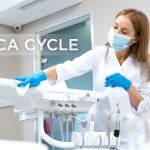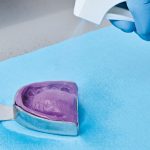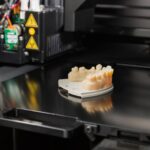20
Sep
Risk of cross contamination: not only for the patient but also between the clinic and the laboratory

Prosthodontic treatment consists of various phases, which involve both health facilities and dental laboratories. This could cause cross contamination between clinics and dental laboratories in charge of developing and preparing dental prostheses.
After addressing cross contamination for the patient, let’s now look at what cross contamination in clinics and laboratories is and how it can be prevented.
The role of pumice stone used to polish dental prostheses
In the past, bacterial cross contamination between a dental laboratory and a dental clinic or surgery was given little attention; however, recent literary articles have addressed the correlations existing between the two facilities, demonstrating that new prostheses were being contaminated during polishing in the laboratory and not just by commensal organisms, but also by pathogen bacteria such as group A and group B streptococci, Staphylococcus aureus, Escherichia Coli and Candida Albicans, originating from new prostheses polished with a pumice stone before being sent to the clinic (Khann et al., 1982).1
In addition, other studies have demonstrated that pumice stone used to polish prostheses may be contaminated by alternative sources to the patient’s prostheses and have Pseudomonas isolated by the water, staphylococci and the species of airborne bacilli.2
Even more attention to the maintenance phase
A very interesting study has examined a further risk of cross contamination in the work phases between the dental facility and the dental laboratory, to be precise between new dental prostheses and prostheses sent to the laboratory for additions and/or repairs.
The results of laboratory tests showed a higher bacterial load in prostheses sent to the laboratory for maintenance, while the lower load was found in new prostheses after polishing with pumice stone.
Staphylococcus aureus was isolated only from 12% of the prostheses sent in the laboratory for additions, but it was not isolated from any new prostheses after polishing with pumice stone.
The above-mentioned study clearly demonstrates the risks of cross contamination in prosthodontics.
How to prevent cross contamination effectively
Cross contamination of equipment that cannot be sterilised in the dental surgery and laboratory represents a danger to the health of the dental surgery team and of the patients.
In accordance with international recommendations, all devices, including impressions, must be accurately cleaned by removing blood residue, saliva and biological residue and then disinfected using hypochlorite solution at 1% or with specific disinfectant solutions with a proven spectrum of action, before delivery to and from the laboratory.
The pumice stone must be prepared with sodium hypochlorite and changed daily. The brushes for polishing prostheses must also be treated with sodium hypochlorite. These recommendations do not eliminate the risk of cross contamination between the dental surgery and the dental laboratory or vice versa, but they do contribute in some way to reducing it and to making the environment for the dental team and for the patient safer.3
Article by Stefania Barbieri
1.Kahn RC, Lancaster MV, Kate W. The microbiologic cross- contamination of dental prostheses. J Prosthet Dent. 1982;47:556-9.
2.Verran J, Winder C, McCord JF, Maryan CJ. Pumice slurry as a cross infection hazard in nonclinical (teaching) dental technology laboratories. Int J Prosthodont. 1997;10:283-6.
3.Neville Debattista, Mario Zarb, John M. Portelli. Bacterial cross-contamination between the dental clinic and laboratory during prosthetic treatment
Do you want more information on Zhermack Dental products and solutions?
Contact us




 Zhermack SpA has been one of the most important producers and international distributors of alginates, gypsums and silicone compounds for the dental sector for over 40 years. It has also developed solutions for the industrial and wellbeing sectors.
Zhermack SpA - Via Bovazecchino, 100 - 45021 Badia Polesine (RO), Italy.
Zhermack SpA has been one of the most important producers and international distributors of alginates, gypsums and silicone compounds for the dental sector for over 40 years. It has also developed solutions for the industrial and wellbeing sectors.
Zhermack SpA - Via Bovazecchino, 100 - 45021 Badia Polesine (RO), Italy.


